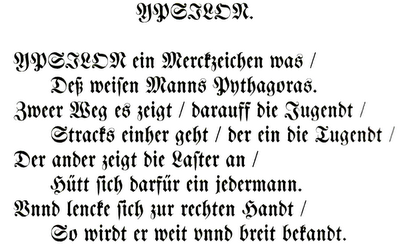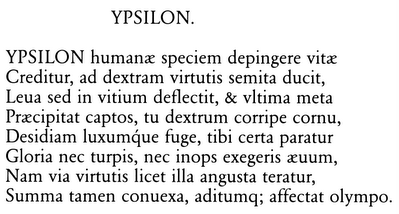De Bry: Ypsilon
This post is a little addendum to Tuesday's post on the Pythagorean Y, mainly for completion's sake. Mr. H. of Giornale Nuovo was kind enough to supply me with the verses in German and Latin that accompany De Bry's illustration; I have reproduced and translated these below. My German is not great, and especially not my Early Modern German, but I've done my best. Credit to Raminagrobis for helping me a bit with the penultimate line of the Latin.



YPSILON ein Merckzeichen was /
___Deß weisen Manns Pythagoras.
Zweer Weg es zeigt / darauff die Jugendt /
___Stracks einher geht / der ein die Tugendt /
Der ander zeigt die Laster an /
___Hütt sich darfür ein jedermann.
Unnd lencke sich zur rechten Handt /
___So wirdt er weit unnd breit bekandt.
The Ypsilon was a symbol of the wise man Pythagoras. It shows a double path; after adolescence one path goes straight on, that of Virtue; the other leads to Vice, which everyone should therefore avoid. And one should keep to the right-hand path, as he knows it becomes wide and broad.

YPSILON humanae speciem depingere vitaeThere are some curious conclusions to be made from these verses. The Latin is clearly heavily based on the pseudo-Vergilian epigram, although it has been rewritten. The last line, I think, deliberately recalls Vergil's Georgics, 4.562, on Augustus, 'viamque adfectat Olympo'. But more interestingly, the verses suggest that the De Bry image shown in the last post is backwards, like the Bade sketch. The central, straight ('Stracks') path should be on the right—the arms are the arms of valour, and the putto at the top is pointing upward to heaven; this path is also 'rounded' at the top. The other branch, which I think should be on the left, 'bends away' from the 'straight and narrow', and its putto is idly whiling away his time. The parrot seems to have little significance; as Mr. H. observes, 'there must be at least a dozen parrots scattered throughout [De Bry's] alphabet.'
Creditur, ad dextram virtutis semita ducit,
Leua sed in vitium deflectit, & vltima meta
Praecipitat captos, tu dextrum corripe cornu,
Desidiam luxumque fuge, tibi certa paratur
Gloria nec turpis, nec inops exegeris aeuum,
Nam via virtutis licet illa angusta teratur,
Summa tamen conuexa, aditumque affectat olympo.
The Ypsilon is believed to depict a scheme of human life; the path of virtue leads to the right, but the left bends away in vice, and at the end hurls down the trapped traveller; you must seize the right horn, and flee idleness and excess—then, certainly, you will be rewarded with glory, and spend your life neither poor nor ugly, for although the way of virtue forms a narrow path, nevertheless the top is rounded, and aims at the entrance to heaven.



3 comments:
Question here - I am deeply ihterested in the Carrollian references and the references to the forked path - the Pythagorean mind, This was a favourite subject of Carroll. However - what is the connection to the digamma, which i have also heard described as the Pthagorean Y and the 'vau' - of Hebrew (Non-Ego, Ego and the merging of the two in perfect balance)? Can anyone help me here? I', a Carroll scholar attempting to complete a book on the Snark
Greetings, Kate--we like Carroll here at the Varieties, so would be happy to help. However, I have never heard of the digamma in connection to the Y (upsilon)--as you know, the digamma looks like an F, so topologically the letters are equivalent. I would be willing to put money on there being no connection made before the 17th century, and I don't even know of any discussions of the digamma before Richard Bentley (c. 1700). The vav (in its Phoenician form) is simply the origin of the Y (and digamma, and U and V and F), although it is unrecognisable in Hebrew.
I have never heard of the 'Freudian Y', either, and I don't recall any specific Pythagorean references in the Carroll I've read ("they pursued it with forks and hope"?), but I don't doubt you're right.
Note: a Google search turns up an association between the digamma and the Pythagorean Y in Pope's Dunciad, Book 4, lines 151 and 218.
Sorry not to be of more assistance--perhaps you will let us know what you find?
A note about the parrot perched on the "Y" : in the earliest depictions of parrots in art, because of their speaking abilities they are regarded as bearing "the prophetic word" .
A parrot is appropriate in this visual fable as a prophet foretelling the divergent paths of life towards good or evil.
See more from this review of a book "Parrots in Art" at: http://www.andrewgrahamdixon.com/archive/readArticle/534
Post a Comment